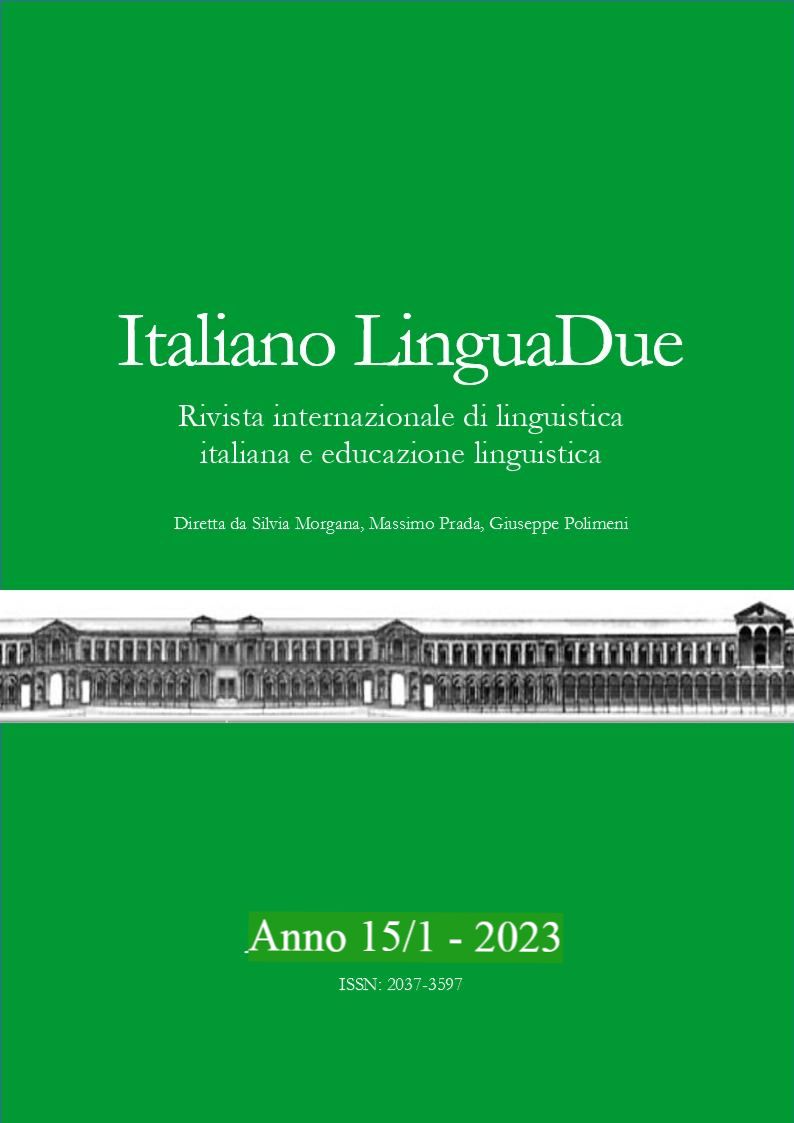«DICEVA CHE ERA ITALIANO»: L’IO E L’ALTRO IN INTERVISTE DI DISCENDENTI DI ITALIANI DI SAN PAOLO
DOI:
https://doi.org/10.54103/2037-3597/20390Abstract
Lo studio della costruzione discorsiva dell’identità è un campo fecondo ‒ e ancora poco esplorato ‒ per comprendere la migrazione. L’integrazione del migrante e dei suoi discendenti nella comunità di destinazione è collegata a rappresentazioni di sé, dell'altro e del mondo, che possono essere comprese meglio attraverso uno studio linguistico-discorsivo. Partendo dall’approccio metodologico della Storia Orale, il gruppo di ricerca “Língua, Identidade e Memória: os italianos no Brasil” realizza interviste con (discendenti di) migranti italiani, incentrate sull’esperienza migratoria diretta o trasmessa dai familiari per investigare in particolare la costruzione dell’italianità degli italo-brasiliani. In questo articolo, analizziamo le occorrenze di “eterogeneità discorsiva mostrata” in cinque interviste con discendenti di italiani arrivati a San Paolo durante la cosiddetta “Grande Emigrazione”. Le domande guida sono: (1) quali caratteristiche vengono associate all’italianità e come vengono presentate nelle occorrenze di eterogeneità mostrata?; (2) cosa possiamo inferire sull’io e sull’italianità dall’incorporazione del discorso altrui in quello degli intervistati? Le ricorrenze evidenziano un’italianità in genere associata a aspetti valutati positivamente, come l’etica del lavoro e la spiccata “allegria”, oltre a una tensione tra enunciatori e italianità.
“HE SAID HE WAS ITALIAN”: THE SELF AND THE OTHER IN INTERVIEWS OF DESCENDANTS OF ITALIANS FROM SÃO PAULO
The study of the discursive construction of identity is a fruitful – and a yet under-explored – field for understanding migration. The integration of the migrant and their descendants into the destination community is linked to representations of self, other, and world, which can be better understood through a linguistic-discursive study. Starting from the methodological approach of Oral History, the research group “Língua, Identidade e Memória: os italianos no Brasil” conducts interviews with (descendants of) Italian migrants, focusing on the direct migration experience or transmitted by family members to investigate in particular the construction of Italian-ness of Italian-Brazilians. In this paper, we analyze the occurrences of shown discursive heterogeneity in five interviews with descendants of Italians who arrived in São Paulo during the so-called “Great Emigration”. The guiding questions are (1) what characteristics are associated with Italian-ness and how are they presented in the occurrences of shown heterogeneity?; (2) what can we infer about the self and Italian-ness from the incorporation of others’ discourse into that of the interviewees? The occurrences show Italian-ness generally associated with positively valued aspects, such as work ethic and marked “cheerfulness”, as well as a tension between the subjects and Italian-ness.
Riferimenti bibliografici
Authier-Revuz J. (1984), “Hétérogénéité(s) énonciative(s)”, in Langages, 19, 73, pp. 98-111.
Caffi C. (1999), “On mitigation”, in Journal of Pragmatics, 31, pp. 881-909: https://doi.org/10.1016/S0378-2166(98)00098-8.
De Fina A. (2003), Identity in Narrative: A study of immigrant discourse, John Benjamins Publishing, Amsterdam-Philadelphia.
Fiorin J. L. (2005 [1989]), Elementos de análise do discurso (13ª ed. revista e ampliada), Contexto, São Paulo.
Franzina E. (2006), A grande emigração: o êxodo dos italianos do Vêneto para o Brasil, Editora da Unicamp, Campinas (trad. di Toledo E., Biondi L. dall’originale La grande emigrazione: l'esodo dei rurali dal Veneto durante il secolo XIX, Marsilio, Venezia, 1976).
Goffman E. (1967), “On face-work: An analysis of ritual elements in social interaction”, in Goffman E., Interaction Ritual: Essays in face-to-face behavior, Doubleday, New York, pp. 5-45.
Halbwachs M. (1990), A memória coletiva, Vértice, São Paulo (trad. di Schaffter L. L. dall’originale La mémoire collective, Presses Universitaires de France, Paris, 1950).
Hall S. (201912), A identidade cultural na pós-modernidade, Lamparina, Rio de Janeiro (trad. di da Silva T. T., Lopes Louro G. “The question of cultural identity”, in Hall S., Held G., McGrew T. (eds.), Modernity and its futures, Politic Press - Open University Press, Cambridge, 1992).
Meihy J. C. S. B., Holanda F. (2007), História oral: como fazer, como pensar, Contexto, São Paulo.
Pollak M. (1989), “Memória, esquecimento, silêncio” (trad. Rocha Flaksman D.), in Estudos Históricos, 2, 3, pp. 3-15.
Sacks H., Schegloff E. A., Jefferson G. (1974), “A simplest systematics for the organization of turn-taking for conversation”, in Language, 50, 4, pp. 696-735.
Santoro E., Maggio G. (2021), “A constituição do “eu” em entrevistas com descendentes de italianos no Brasil: tempo e espaço como marcas de memória e identidade”, in Revista del CESLA, 27, pp. 113-132.
https://doi.org/10.36551/2081-1160.2021.27.113-132.
Trento A. (2016), “Italiani a São Paulo tra lavoro e tempo libero, 1880-1940”, in Navegar: Revista de estudos e e/imigração, 2, 2, pp. 9-28.
http://www.labimi.com.br/navegar/edicoes/02/TEXTO_COMPLETO_numero2.pdf.
Dowloads
Pubblicato
Fascicolo
Sezione
Licenza

Questo lavoro è fornito con la licenza Creative Commons Attribuzione - Condividi allo stesso modo 4.0.




